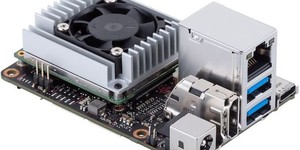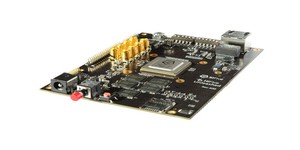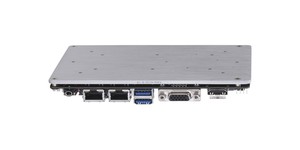Asus launches Raspberry Pi-like Tinkerboard SBC
January 20, 2017 | 10:35
Companies: #arm #asus #raspberry-pi #rockchip

Asus has officially launched its long-rumoured entry into the maker market, targeting the Raspberry Pi with a more powerful single board computer (SBC) it calls the Tinkerboard.
To say the Asus Tinkerboard is inspired by the Raspberry Pi is putting it perhaps a little too mildly: The two SBCs are near-identical in terms of layout and functionality. Both are powered from a micro-USB port on the bottom edge of the board, next to an HDMI port and a 3.5mm audio jack; the right-hand edge features an Ethernet connector and four USB 2.0 ports; the upper edge is home to a 40-pin GPIO connector using male pin headers; and the top of the board includes CSI and DSI connectors for cameras and displays.
Asus, it seems, isn't looking to innovate with the Tinkerboard but instead compete with the Raspberry Pi in an out-and-out slugfest. The device's key claims to fame are all based around its specifications, starting with a quad-core 1.8GHz ARM Cortex-A17 processor from Rockchip. While lacking the 64-bit capabilities of the BCM2837 from the Raspberry Pi 3, it boasts a faster 1.8GHz clock speed and the promise of dramatically improved performance - aided by 2GB of dual-channel LPDDR3 memory, twice the RAM available on any Raspberry Pi model. The Rockchip's GPU is the Mali T760, which Asus claims is capable of upscaling 1080p content to 4K at 30fps as well as handling H.264 and H.265 decoding in hardware. There is also an upgrade to the audio compared to the Raspberry Pi, with the Tinkerboard having 24-bit 192kHz output support.
Another major improvement comes from the Ethernet port, which claims gigabit connectivity and a dedicated connection to the Rockchip SoC. Compared with the 10/100 connectivity of the Raspberry Pi, which shares a single USB channel to the SoC with all other USB devices on the system, the board has the potential to offer significantly improved network performance. It keeps up with the Raspberry Pi 3 on the wireless front, too, with a module offering 802.11b/g/n Wi-Fi and Bluetooth 4.0 + EDR - a step down from the Raspberry Pi 3's onboard Bluetooth 4.1 and Bluetooth Low Energy (BLE), true, but with the added bonus of an option to install an external antenna for boosted range.
Price, though, is where Asus's device falls down: At £55 including VAT, the Tinkerboard is considerably more expensive than the £34 Raspberry Pi 3. Whether its real-world performance will prove the price difference a worthwhile investment remains to be seen, while those who are looking to pick up a unit should bear in mind that only two operating systems are currently compatible: a tweaked Debian Linux and a second variant which boots directly into the Kodi media player.
The Asus Tinkerboard is available now from CPC.
To say the Asus Tinkerboard is inspired by the Raspberry Pi is putting it perhaps a little too mildly: The two SBCs are near-identical in terms of layout and functionality. Both are powered from a micro-USB port on the bottom edge of the board, next to an HDMI port and a 3.5mm audio jack; the right-hand edge features an Ethernet connector and four USB 2.0 ports; the upper edge is home to a 40-pin GPIO connector using male pin headers; and the top of the board includes CSI and DSI connectors for cameras and displays.
Asus, it seems, isn't looking to innovate with the Tinkerboard but instead compete with the Raspberry Pi in an out-and-out slugfest. The device's key claims to fame are all based around its specifications, starting with a quad-core 1.8GHz ARM Cortex-A17 processor from Rockchip. While lacking the 64-bit capabilities of the BCM2837 from the Raspberry Pi 3, it boasts a faster 1.8GHz clock speed and the promise of dramatically improved performance - aided by 2GB of dual-channel LPDDR3 memory, twice the RAM available on any Raspberry Pi model. The Rockchip's GPU is the Mali T760, which Asus claims is capable of upscaling 1080p content to 4K at 30fps as well as handling H.264 and H.265 decoding in hardware. There is also an upgrade to the audio compared to the Raspberry Pi, with the Tinkerboard having 24-bit 192kHz output support.
Another major improvement comes from the Ethernet port, which claims gigabit connectivity and a dedicated connection to the Rockchip SoC. Compared with the 10/100 connectivity of the Raspberry Pi, which shares a single USB channel to the SoC with all other USB devices on the system, the board has the potential to offer significantly improved network performance. It keeps up with the Raspberry Pi 3 on the wireless front, too, with a module offering 802.11b/g/n Wi-Fi and Bluetooth 4.0 + EDR - a step down from the Raspberry Pi 3's onboard Bluetooth 4.1 and Bluetooth Low Energy (BLE), true, but with the added bonus of an option to install an external antenna for boosted range.
Price, though, is where Asus's device falls down: At £55 including VAT, the Tinkerboard is considerably more expensive than the £34 Raspberry Pi 3. Whether its real-world performance will prove the price difference a worthwhile investment remains to be seen, while those who are looking to pick up a unit should bear in mind that only two operating systems are currently compatible: a tweaked Debian Linux and a second variant which boots directly into the Kodi media player.
The Asus Tinkerboard is available now from CPC.

MSI MPG Velox 100R Chassis Review
October 14 2021 | 15:04








Want to comment? Please log in.